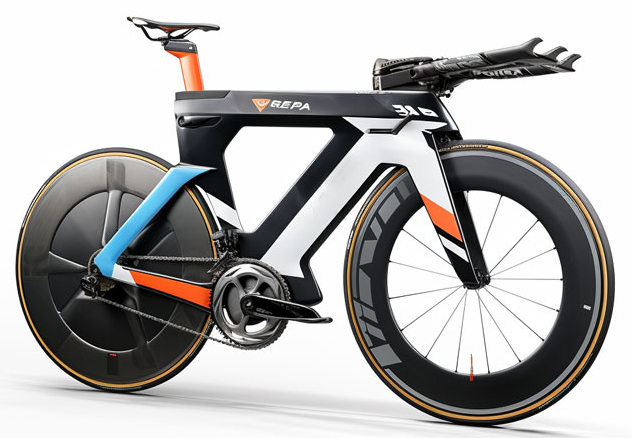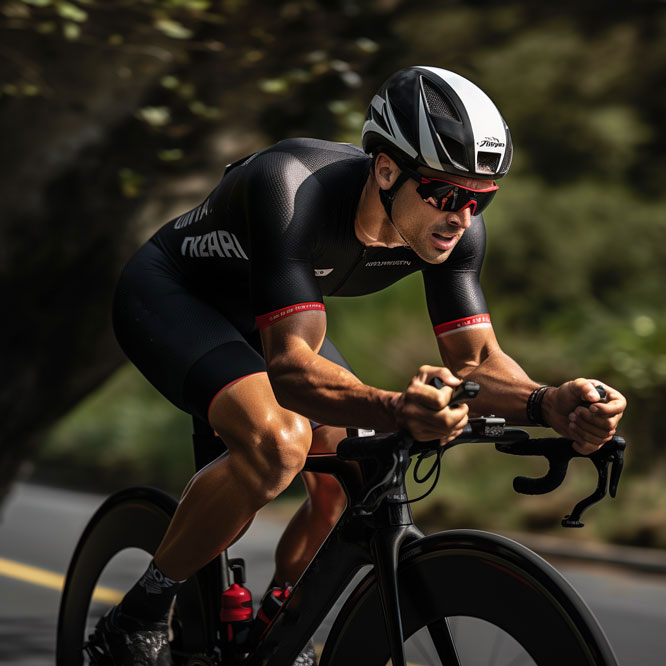What Is A Triathlon Bike?
Your Ultimate Guide to Speed and Performance
What is a Triathlon Bike?
So, what is a triathlon bike and how is it different?
A triathlon bike, often referred to as a Tri bike, is a specialized bicycle designed to optimize speed and aerodynamics.
Unlike traditional road bikes, triathlon bikes are engineered to reduce wind resistance, allowing athletes to maintain higher speeds with less effort.
These bikes are meticulously crafted to enhance performance during the cycling leg of a triathlon.
The cycling segment is the longest of the three disciplines and can significantly impact your overall performance.
A dedicated bike is not just a fancy accessory; it’s an essential piece of gear that can make or break your race.
So, let’s ride into the heart of the matter and explore the question – ‘What is a triathlon bike?’
What Are The Features Of A Triathlon Bike?
Aerodynamic Frame Design
The cornerstone of a triathlon bike’s prowess is its aerodynamic frame design.
These frames are meticulously engineered to cut through the air with minimal resistance, allowing you to maintain higher speeds with less effort.
The tubing is often shaped to reduce drag, and the frame geometry encourages a more forward-leaning position to further streamline your profile.
Every curve and contour is optimized to maximize your speed potential.
Integrated Aerobars
These bikes typically come equipped with integrated aerobars or ‘Tri-bars’.
These handlebars allow you to rest your forearms while maintaining an aerodynamic position. This reduces the strain on your upper body and keeps you comfortable during longer rides.
By reducing your frontal area exposed to wind, you’ll find yourself slicing through the air more efficiently, saving energy during the bike leg of your race.
Integrated aerobars also allow you to comfortably maintain your speed while conserving energy for the run to come.
Adjustable Saddle Positions
Long-distance triathlons require hours of continuous cycling, which means comfort is paramount.
Tri bikes often feature adjustable saddle positions that let you fine-tune your seating arrangement for maximum comfort and efficiency.
The ability to make micro-adjustments to your saddle angle and height ensures that you’re in an optimal position to produce power while minimizing strain on your muscles.
Deep Dish Wheels
To further enhance aerodynamics, many triathlon bikes are equipped with deep dish wheels.
These wheels have a distinct profile that reduces turbulence and drag caused by crosswinds, helping you maintain your speed and stability even in challenging conditions.
While they may not be as responsive as traditional wheels, their aerodynamic advantage can be a game-changer during flat and fast segments of the race.
Transition-Friendly Geometry
Triathlon races involve swift transitions from swim to bike and then from bike to run.
Triathlon bikes are designed with transition-friendly geometry to facilitate quick and smooth mount and dismount actions.
This means you can seamlessly switch from the swim to the bike leg without losing precious time.
A steeper seat tube angle and higher bottom bracket can aid in swift transitions and a faster start to your ride.
Gear Ratios
Tri bikes often have a specific gear setup that prioritizes higher speeds.
They typically have larger chainrings in the front and a wider range of gears in the back, allowing for smooth pedaling even on challenging terrain.
Storage Solutions
Long races require carrying essentials like nutrition, hydration, and tools.
Many tri bikes offer storage solutions built right into the frame.
You’ll find integrated hydration systems, bento boxes, and storage compartments strategically placed to minimize aerodynamic drag while providing easy access to your necessities.
In essence, a triathlon bike is purpose-built to provide you with the tools you need to excel during the cycling leg of a triathlon.
With a focus on aerodynamics, comfort, and efficiency, these bikes empower you to tackle the bike course with confidence and set the stage for a strong run to the finish line.
Advantages of Using a Triathlon Bike
Enhanced Speed
The aerodynamic design of a triathlon bike can lead to substantial speed gains. By minimizing wind resistance, you can maintain higher velocities without exerting excessive energy.
Energy Conservation
Reduced wind drag means you can cover more distance with each pedal stroke. This conservation of energy becomes particularly crucial as you transition from cycling to running.
Optimized Position
The aggressive geometry of a tri bike positions your body to cut through the wind efficiently. This posture also engages different muscle groups, preventing fatigue in a single muscle area.
Customization
Triathlon bikes can be customized to fit your body perfectly. A proper fit reduces discomfort, minimizes the risk of injury, and ensures you’re using your energy efficiently.
Transition Efficiency
Triathlon bikes are designed for quick transitions. You can easily switch from swimming to cycling and then to running, ensuring a smooth progression through each leg of the race.
Exploring the Triathlon Bike Categories
Triathlon bikes can be categorized into three main types, each tailored to different race distances and personal preferences:
Sprint Distance Bikes
Sprint triathlon bikes are versatile and suitable for shorter races. They provide a balance between aerodynamics and comfort, making them ideal for beginners and those focusing on shorter distances.
Olympic Distance Bikes
Olympic distance tri bikes strike a balance between speed and endurance. They offer enhanced aerodynamics and comfort for races that cover longer distances.
Ironman Distance Bikes
Ironman triathlon bikes are built for the long haul. They prioritize comfort and endurance, allowing athletes to maintain a steady pace over the grueling Ironman distances.
FAQs: Your Burning Questions Answered
How does a triathlon bike differ from a road bike?
A triathlon bike is designed with aerodynamics in mind, featuring aero-shaped frames, handlebars, and wheels. The riding position is more aggressive to minimize wind resistance. In contrast, a road bike focuses on versatility and comfort for various terrains.
Can I use a road bike for a triathlon?
Yes, you can use a road bike for a triathlon, especially if you’re a beginner. However, a triathlon bike’s aerodynamic design and specialized features can give you a significant advantage in terms of speed and efficiency.
What should I consider when buying a tri bike?
When buying a tri bike, consider factors like your budget, the race distances you’ll be participating in, the bike’s fit, and its aerodynamic features. A professional bike fitting can help you find the right size and setup for your body.
What is the difference between a triathlon bike and a time trial bike?
Purpose and Design: Triathlon bikes excel in multisport events with comfort-focused geometry and integrated storage, while time trial bikes prioritize solo speed with aerodynamic frames and components.
UCI Impact: Time trial bikes must adhere to strict UCI regulations for professional races, governing aspects like tube thickness and saddle position to ensure fairness.
Innovation vs. Compliance: Triathlon bikes innovate freely for aerodynamics and convenience, while time trial bikes balance creativity with UCI rules, resulting in dynamic frame designs.
How do I maintain my triathlon bike?
Regular maintenance is crucial to keep your triathlon bike in top condition. Clean and lubricate the chain, regularly check tire pressure, keep the brakes properly adjusted, and ensure all components are functioning smoothly.
Can I use clip-on aero bars on my road bike?
Yes, you can add clip-on aero bars to your road bike to achieve a more aerodynamic position. However, keep in mind that road bike geometry might not be as optimized for aerodynamics as a dedicated triathlon bike.
Do I need a professional bike fitting?
A professional bike fitting can greatly enhance your comfort and performance on a tri bike. It ensures that your bike is adjusted to fit your body’s unique proportions, reducing the risk of discomfort and injury during long rides.
Conclusion: Embark on a Triathlon Adventure
In the exhilarating world of triathlons, a bike isn’t just a piece of equipment – it’s your key to conquering new challenges and pushing your limits.
From its aerodynamic prowess to its integrated storage solutions, every aspect of a tri bike is designed to enhance your performance and elevate your experience.
So, whether you’re a seasoned triathlete or a cycling enthusiast looking to take on new horizons, a triathlon bike is your ultimate companion on this multisport journey.


 bicycleandbikes.com
bicycleandbikes.com bicycleandbikes.com
bicycleandbikes.com